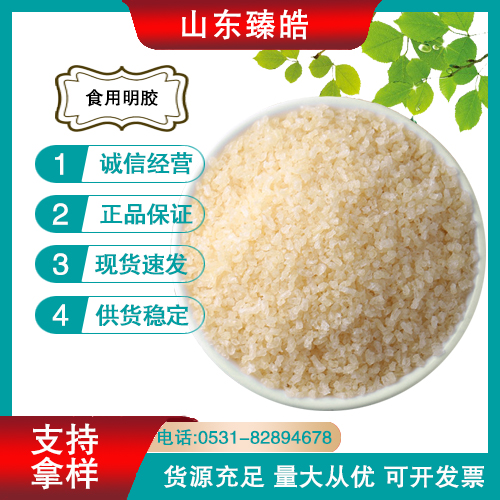As one of the food additives, gelatin may not be well understood by many people, but if you pay attention to the packaging boxes of soft candy, yogurt, or beverages, you may see it in the ingredient list. In order to give everyone a better understanding of gelatin, we will introduce it from aspects such as the source of raw materials, applications, and product classification.

一、 What is gelatin?
Gelatin is a white or light yellow, translucent, slightly shiny sheet or powder that is partially degraded by collagen in connective tissue such as animal skin, bone, muscle membrane, and muscle gland, so it is also called animal gelatin or fat glue. Gelatin is tasteless and odorless, absorbs water and expands in cold water, is soluble in hot water, glycerol and acetic acid, and is insoluble in ethanol and ether.
二、 Classification of gelatin
1. According to different production methods (hydrolysis methods during production), gelatin can be divided into acid gelatin (also known as A-type gelatin), alkali gelatin (also known as B-type gelatin), enzymatic gelatin, and hydrolyzed gelatin. The biggest difference among the first three types of gelatin is that different methods are used in the pretreatment process during the gelatin production process.
Acid gelatin (also known as A-type gelatin): refers to the gelatin obtained by pretreatment of raw materials in an acidic medium and extraction in an acidic medium. Type A gelatin is mainly extracted from animal skin and bones aged 6 to 9 months by acidification (pH 3.5 to 4.5) for 10 to 48 hours. The isoelectric point of acid gelatin is between pH 6.8 to 8.5 (bone glue) and 7.5 to 9.5 (skin glue).
Alkaline gelatin (also known as B-type gelatin): The output of B-type gelatin ranks first among the three types of gelatin. The raw material is pretreated in an alkaline medium, neutralized, and extracted in a neutral medium. Type B gelatin is mainly made from 2 to 5 years old bovine bones and skins, and is extracted after 6 to 8 weeks of alkaline treatment. The isoelectric point of alkaline gelatin is between 4.5 and 5.3 pH.
Enzymatic gelatin: refers to gelatin extracted from raw materials through enzymatic pretreatment in a medium with a moderate pH value.
Hydrolyzed gelatin: Using the bones and skins of cattle, pigs, and other animals as raw materials, hydrolyzing them under the action of alkali, acid, heat, or enzymes to produce a small molecule gelatin solution. After refining, grading, and adjusting their molecular weight, they undergo separate post processing to obtain various hydrolyzed gelatin products with different molecular weights.
2. According to different raw materials, gelatin can be divided into skin gelatin, bone gelatin, and halal gelatin.
"Skin gelatin: A crude product of animal glue extracted directly from animal skins, such as cow and pig skins. It is generally a yellow or brown block translucent or opaque substance with low purity and a special odor, and its molecular weight varies from 175 to 4500.".
Skin gelatin: It can be subdivided into cow skin gelatin, pig skin gelatin, chicken skin gelatin, fish glue, fish bladder glue, etc.
Bone gelatin: It is made from animal bones such as cattle and pigs through processes such as crushing, hydrolysis, filtration, and drying. It is a light yellow to yellowish brown, translucent, slightly shiny spherical particle, odorless, and free of impurities visible to the naked eye. It is also known as bead like bone gelatin due to its appearance as a bead like particle.
Bone gelatin: It can be subdivided into bovine bone glue, pig bone glue, chicken bone glue, fish bone glue, etc.
"Halal gelatin: Food additive made from edible animals (cattle, sheep, chicken, fish, etc., not allowed to use pigs and their products as raw materials) that comply with Islamic Shariah.".
3. According to different quality, gelatin can also be divided into high-grade gelatin, low-grade gelatin, and bone glue. High-grade gelatin is referred to as gelatin for short, and Gelatin is known abroad. Low-grade gelatin and bone glue are referred to as Glue.
三、 Gelatin Application
Gelatin is a kind of macromolecular hydrophilic colloid, which is a low calorie health food with high nutritional value and can be used to make candy additives, frozen food additives, etc. In addition, gelatin is also widely used in the pharmaceutical and chemical industries.